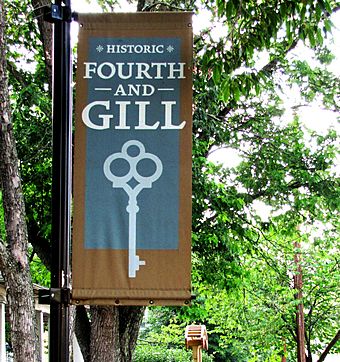Fourth and Gill, Knoxville facts for kids
Quick facts for kids |
|
|
Fourth and Gill Historic District
|
|
 |
|
| Location | Roughly bounded by I-40, Broadway, Central, and Hall of Fame Knoxville, Tennessee |
|---|---|
| Area | approximately 72 acres (29 ha) |
| Built | 1880–1930 |
| Architect | Baumann Brothers, George F. Barber; multiple |
| Architectural style | Queen Anne, Bungalow/Craftsman, Mediterranean Revival, Gothic Revival |
| NRHP reference No. | 85000948 |
| Added to NRHP | April 29, 1985 |
Fourth and Gill is a historic neighborhood in Knoxville, Tennessee. It's located just north of the city's downtown area. This neighborhood was first built in the late 1800s. It was a place for middle-class families and professionals to live.
Today, Fourth and Gill still has many of its original Victorian-style houses and churches. These buildings show what the area looked like over a hundred years ago. In 1985, 282 houses and other buildings here were added to the National Register of Historic Places. This means they are officially recognized as important historical sites.
Knoxville grew very fast after the American Civil War. This led to a big demand for new homes. Factories and businesses were built near the railroad north of the city. Fourth and Gill was one of the neighborhoods created for the people working in these new industries. The area is named after a community center. This center opened in 1960 at the corner of North Fourth Avenue and Gill Avenue.
Contents
Where is Fourth and Gill?
The Fourth and Gill neighborhood is easy to find. It's bordered by Hall of Fame Drive on the east. Broadway (which is part of U.S. Highway 441) is on its west side. Glenwood Avenue is to the north, and East Fourth Avenue is to the south.
Nearby communities include Old North Knoxville to the north. Parkridge is to the east, across Hall of Fame Drive. The Emory Place Historic District is just south of Fourth and Gill. Many streets like Morgan, Gratz, and Luttrell run through the neighborhood.
A Look Back: Fourth and Gill's History
For most of the 1800s, the land where Fourth and Gill now stands was just open fields. But things changed when the East Tennessee and Georgia Railroad was built nearby in 1855. This made it easier to develop the area. After the Civil War, more factories were built along the railroad. This created many jobs and a need for new homes.
Around 1880, the first houses started to appear in Fourth and Gill. The area grew quickly. Because Knoxville was slow to add these new areas to the city, part of Fourth and Gill became its own city. This new city was called North Knoxville, and it was formed in 1889.
North Knoxville had its own mayor, L.A. Gratz, who has a street named after him. It also had its own school and electric street lights. Many important people built homes in Fourth and Gill during the 1880s and 1890s. For example, Tennessee governor Robert Love Taylor lived here. The famous architect Albert B. Baumann, Sr. designed a house for his family.
Over the years, other notable residents lived in Fourth and Gill. These included furniture maker James G. Sterchi and philosopher Albert Chavannes.
In the 1930s, cars became popular. People started moving out of the city to live in suburbs. Fourth and Gill began to decline. Many large houses were split into smaller apartments. But in the late 1970s, the neighborhood started a successful renewal project. Many of its beautiful old houses have been fixed up and restored.
Fourth and Gill Historic District
The Fourth and Gill Historic District was added to the National Register of Historic Places in 1985. It includes over 250 houses, a school, and three churches. All these buildings were constructed between 1880 and 1934.
What makes Fourth and Gill special is that most of its original buildings are still there. Unlike some other old neighborhoods, it doesn't have many new, modern buildings mixed in. Many houses from the 1880s to early 1900s are in the Queen Anne style. Later houses often show Bungalow or Craftsman designs. You can also find other styles like Gothic Revival and Mediterranean Revival.
Cool Buildings to See
Here are some of the interesting buildings in the Fourth and Gill Historic District:
- The Knoxville House of Faith (816 Lovenia) is a two-story church. It was built in 1908 in the Gothic Revival style.
- Central United Methodist Church (201 Third Avenue) is another two-story Gothic Revival church. It was built in 1927.
- 800 Luttrell Street is a two-story church building. It was built in 1929 in the Tudor Revival style.
- 800 Deery Street is a one-story Queen Anne-style cottage. It was built around 1890 and designed by architect George Barber.
- 839 Deery Street is a one-story Queen Anne-style cottage. It was designed by Albert Baumann, Sr., a famous architect.
- The Eugene H. Wilson House (941 Eleanor) is a two-story Colonial Revival-style house. It was built around 1905.
- The Mrs. J. W. Taylor House (703 Luttrell) is a one-story Queen Anne-style cottage. It was built in 1902.
- Cleveland Park (729 Morgan) is a three-story apartment building. It was built around 1925 in the Mediterranean Revival style.
- 800 North Fourth Avenue is a two-story house built in 1891. It now serves as the Fourth and Gill community center.
The Caswell-Taylor House (803 North Fourth Ave.) was once the home of Governor Robert Love Taylor. This two-story Queen Anne-style house was built around 1880. It was part of the historic district but is no longer standing today.








